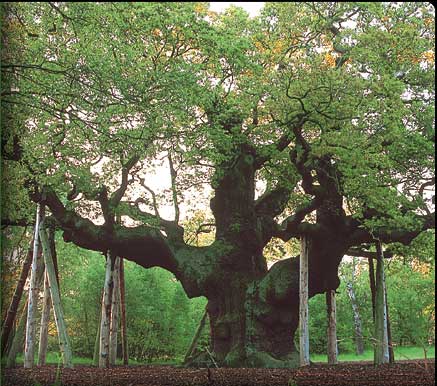
|
Introduction
The Domesday Book in 1086 noted that Sherwood Forest covered most of Nottinghamshire above the River Trent.
Large trees were seen as a medium of prophecy and knowledge. These trees were associated with woods like Sherwood. Large oaks were frequently depicted as dwelling places for woodland spirits and legend has it that Robin Hood hid from his enemies inside the Major Oak.
Return to the top
|

|
An Accident of Nature?
There are several theories as to what caused the tree to grow into the size and shape it is today.
One is that the major Oak may in fact be more than one tree! Perhaps as a consequence of a chance germination of an acorn some 800 years ago, three or four trees began to grow close to one another. The tree we see today is the product of these young saplings fusing together as they grew to form one enormous oak. There are large grooves visible on the outside, and the hollow interior is actually several open chambers combined together, which is evidence that this is a possibility.
Another theory is that the tree has been pollarded. This was a system of tree management that enabled the foresters to grow more than one crop of timber from a single tree. This was repeated every 40-50 years causing the trunk to grow large and fat, the tops of which became swollen after several centuries of this cropping. This system of management allowed trees to grow longer than unmanaged trees. Some have been found to be 1000 years old. This tree was probably spared from the final forester's axe because of its hollow rotted trunk. The tree was probably spared also because of its landscape and heritage value. Romantic stories of Robin Hood only added weight to the case for the tree's preservation.
However, there are at least 20 oaks in England and Wales with a girth greater than the Major Oak, so oak trees this large may not have been unusual a few hundred years ago.
Return to the top
|

|
Care and management
The Major Oak has received special attention throughout this century
In 1908, metal straps and chains were installed high up in the canopy to support the weakest branches. Large holes were covered in lead sheeting to prevent rain entering, but unfortunately this was later removed by some distant relatives of Robin's merry band.
Supports in the form of wooden poles were also first used for support about this time.
By 1972 the pressure of thousands of visitor's feet (220,000 per year) was beginning to take its toll, causing the upper branches to die back, soil compaction had prevented rain water, and minerals from the leaf litter decomposition, percolating down to the roots nourishing the tree.
In 1975 when the new Visitor Centre was built by Nottinghamshire Council, a fence was installed around the great tree, preventing further damage from the ever increasing number of visitors to Sherwood. This fence keeping visitors away from the tree helped to save it for the future, as it still does today.
A tree company (Tree Surgeons) was brought in to treat the tree by removing decaying branches, cover up gaping holes, replace some of the old chains and straps and give the exposed wood, both inside and outside, a coat of arboricultural paint to prevent further decay. However, a complete eradication of fungi can prove almost impossible and can sometimes be seen on the tree in the Autumn.
In the mid 80's more supports were added, these prevent sideways, horizontal movement of the larger lower limbs.
In 1994 the grass under the tree's canopy which had originally been introduced for aesthetic purposes, was removed to prevent it taking soil nutrients from the tree. An inert mulch was then spread to prevent the soil from drying out. Outside the "drip circle" the natural regeneration of the woodland flora is being allowed to grow back. The tree is now inspected on a daily basis by the Ranger staff, whilst Tree Surgeons visit the site on a seasonal basis to check the oak for routine maintenance and rout feeding.
With your support and respect, this grand old tree may live for many years to come. But, it may be remembered that the Major Oak, even guarded by the spirits of the greenwood and Robin Hood, is not immortal.
Return to the top
|

|
Natural History
The Major Oak is listed as being an English or pedunculate oak (Quercus robur)
Its leaves begin to grow in April-May and stay on until October-November, depending on the severity of the first Autumn frosts. The tree flowers, small catkin like structures (male) and the much smaller female flowers with dark stigmas, are produced soon after the leaves have opened.
The acorns of the pedunculate oak grow on stalks and they mature in late October. Generally the tree has a good acorn crop; sometimes known as mast every 2-3 years. Good acorn crop masts only occur in the years when the spring weather is warm and dry enough to allow the oak flower to be pollinated successfully.
The oak's great hollow interior is not man-made, it is actually caused by fungi, the most invasive of which is called the "poor man's Beefsteak" (Fistulina hepatica) whose fruiting bodies are sometimes seen growing on the bark of the tree during the Autumn.
Like all other oaks, the Major Oak provides plenty of food for caterpillars and insects, its deeply fissured bark furnishes them with many hiding places, giving much needed protection from predators.
The Major Oak's enormous interior is also useful for hibernating insects and mammals such as bats, queen wasps, butterflies and a variety of spiders. All make use of the valuable protection and shelter the tree has to offer during the harsh winter weather.
In the Spring, many birds including jackdaws, woodpeckers and great tits make their nest in what is Sherwood's most famous Oak. Look out for young grey squirrels in May-June as they make their first journeys away from their nests, you can often see them practising their tightrope acts on the oak's network of supporting cables.
So, not only are these ancient trees inspirational in their beauty, majesty and spiritual qualities, they are also unrivalled as natural habitats among the many species of woodland trees. Each one is an individual nature reserve, it can act as host to over 32 species of mammal, 68 species of bird, 34 species of butterfly, 271 species of insect, 168 species of flower, 10 species of fern and 31 species of fungi or lichen. Amongst them all stands the Major oak, a giant in all respects and worthy of a place in all our hearts.
Return to the top
|

|
Local History
It is probable that this ancient tree was named after a local historian.
The Major Oak's first recorded name was the Cockpen tree, this was with reference to its earlier use as a cockerel pen during the mid 18th century. The poor unfortunate game birds were stacked inside the tree in wicker baskets or just tied in hessian sacking, before they were released and mercilessly thrown together for this barbaric sport.
The tree did not become well known until about 200 years ago when in 1790 the tree was described by a Major Hayman Rooke FSA, who was a local historian from the Mansfield area. In the same year, he published a book entitled "Remarkable Oaks in the park of Welbeck in the county of Nottingham", it was soon after this that the tree was named after him. Its name means "The Major's Oak" and not the largest oak.
However, the "ancient oak" mentioned in Hayman Rooke's 1790 book "Remarkable Oaks" as "Plate IX" may not be the Major Oak as it is known today. The branches look different and the opening
points in a different direction (today's opening looks South). Compare
150 other photos of the big tree taken since 1880 in the Major Oak Gallery.
One idea is that the engraving has been
reversed somehow.
|
Throughout the last century, it was also known as the Queen or Queen's Oak - there is no known connection with any Royal figure - this name probably just described its large size and its status as Lady of the Forest, because it was such a majestic tree.
Return to the top
|

|
A Tourist Attraction
In Victorian times, the Major Oak became a popular visiting place, although it was always well known by local people. People visited the tree, coming to Edwinstowe by train and then by carriage to see the tree.
This tree still continues to draw the crowds with over 600,000 people from all over the world coming to visit this venerable giant each year.
Whilst this tree is not the largest girth in the country, it is certainly the most famous surrounded by mystique and folklore. We hope that it will continue to be so for many years and provide a joy to see for people from all over the world in this ancient forest of Sherwood.
Return to the top
The above text is taken from leaflet 8876 "The Major Oak" obtained from Sherwood Forest Visitor Centre, Edwinstowe, Mansfield, Nottinghamshire NG21 9HN produced by Nottinghamshire County Council Community Services price 50 pence.
|

|
Venerable Guardians
A previous Guardian
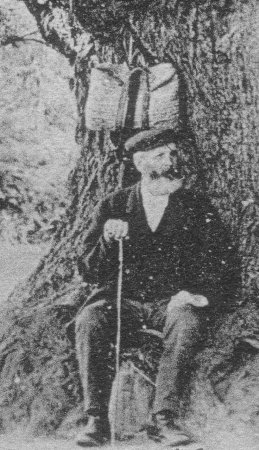
Sat on a seat attached to the oak, his lunchbag
hanging above, he seems to have a patch over his left eye. He appears in several old photos
|
Tom Thompson
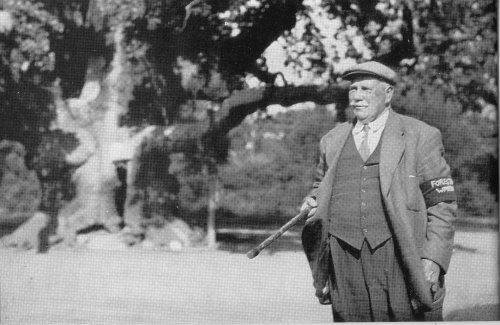
The Guardian's seat, bag, stick and brolly.
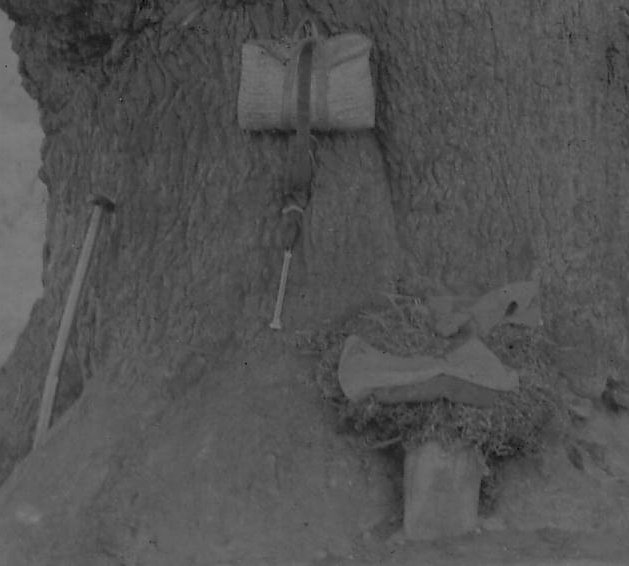
|
In 1960, this was written about Tom Thompson:
Tom Thompson, 80-year-old guardian of the Major Oak - he holds office from the Thoresby Estate, and proudly wears his red armband of authority - spends most of his waking hours at the tree, protecting it from the thoughtless smoker, and vandalism of the souvenir-hunter. He is also by way of being an authority on Robin Hood, whose life and legend he has studied.
He tells us that the Major Oak is 64 feet in circumference. Its hollow was found - or made, by Robin Hood's men in 1216. Today, that hollow has been known to shelter 34 school children. It must have been a squeeze, but Tom packed them in himself! The greatest number of visitors to it in one day is approximately 15,000 - on August Bank Holiday, 1957 - a tribute to the grip that Robin Hood has on the minds of the English.
Tom points to a number of animal shapes seen in the gnarled boughs of the majestic old tree - the heads of a bulldog, a rhinoceros, a monkey, a buffalo, a ram. an elephant - and of course, of a stag - and the figure of an elephant sitting up!
"I've had people of every race under the sun come up to see the Major Oak in the 10 years I've been Warden", says Tom.
The above text is taken from booklet "A History of the Sherwood Oaks", price 2/6, printed by Linneys of Mansfield "in the heart of England's Sherwood Forest".
|

|
New Sherwood
Hello, my name is John Palmer and I live in Dorset, England. When I was a boy I was taken to see the Major Oak and have loved the great tree ever since. In October 2000 I collected 500 acorns from the Major Oak and planted them in 3 inch pots at home. Here they got "tender-loving-care" and the best ones were potted up next May into 5 inch pots. When they were a year old, many were straight, sturdy and over a foot high. The best 300 saplings were potted up into 10 litre pots the second year. My back garden was rather full of pots, as you can imagine!
At first my intention was to give these "mini-Major Oak" saplings away free to organisations and other enthusiasts who could collect the trees themselves. This will still be done in special cases where sufficient need can be established.
But problems loomed, many people from abroad wrote to me asking for saplings or acorns, and I soon discovered this was not permitted by Customs without raising a Phytosanitary Certificate at considerable expense and effort.
In 2002 I was fortunate enough to purchase at an Auction a 7 acre pasture field in Dorset, surrounded by mature hedges and trees, and well away from the "madding crowd". Researching old Tithe Maps at the Dorset Record Office revealed that this field was involved in the Inclosures Act and in 1813 nearby fields were called "Great Wood" and "Little Wood". Today the trees have vanished, but an idea was planted in my head.
In 2004 I planted my best 270 "mini Major Oaks" in the 7 acre field, where I hope they will be able to grow into a miniature Sherwood Forest. This is a long-term project, and I will never live to see the trees in all their mature glory, but at least I can start them on their way with love and respect and help them grow in age and stature as did their famous parent.
Preparing the field has been a big project - hedging, burning hedge offcuts, ditching, reseeding ditch spoil lines, grass cutting, bailing, bagging and removing, digging a well, tree surgery on several big ashes in the hedges, building a deer-proof enclosure, improving the track for equipment access, purchase of a 4x4, bringing the oaks in containers to the enclosure, building a rope and pulley system to get water out of the well, using an old bath to store the water and watering the saplings every other day in the summer! The little oaks have been attacked by field-voles, grass and ants. The voles have been eaten by kestrels, owls and foxes. Late frost shrivelled new leaves, but the little trees fought back and recovered and are now growing well.
To keep them company we have planted 29 willow trees, some of them named after each team member in the tremendously exciting Ashes Series at cricket in 2005.
Working in the field has been idyllic, surrounded by wildlife and no other humans. Read a
Newspaper report and a
BBC Feature about all this.
An "Oak Blog" or personal diary lists events in the field since 1996.
I hope that those who have e-mailed me, asking for acorns or even saplings to be posted, will realise that this is not legal or practical. I do regret raising their hopes, but feel that my "New Sherwood" project is the best way of ensuring these oaks grow into a size that will give pleasure to future generations.
Return to the top
|

|
Major Oak clones
Clones (exact genetic replicas) of the Major Oak are available from:
British Heritage Trees.
Kirk Ley Road,
East Leake,
Loughborough,
Leicestershire LE12 6PE
Fifty clones are produced each year, are subject to bid by postal tender, with minimum bid of £300. Trees can be posted to Europe and USA. Ask for leaflet for full details.
Further information dated 4jan2016
Micropropogation Services (EM) Ltd, Kirk Ley Road, East Leak, Loughborough, Leicestershire, England LE12 6PE
Index
Major Oak
Order form
|
Return to the top
|

|
Website library
There are some interesting angles on the Major Oak from a diversity of other websites - like the host of species living on the old oak itself! To see over 3,000 websites mentioning the Big Tree, go to the
GOOGLE search engine, enter the words Major Oak Sherwood and clicking on "Google search".
Return to the top
|

|
E-mails
Hello, Mr. Palmer:
Well, I've just finished speaking with our Canadian authorities about having one or more acorns sent in from England. The official response was that this is not possible at this time. Their reasoning is that in California at the present time, there is a very real problem with oaks dying of a fungus which it is suspected may have been introduced from a European or other unnamed source. As a result, oak saplings, acorns or any other seed products are not being imported through the Canadian Food Inspection Agency. These folks are simply doing their job, so although I have my own thoughts on the matter, officially I cannot import any acorns. I must leave it to your discretion as to whether a small brown gift package with no return address might find its way into the mails. Either way, I do thank you very much for your efforts in distributing the acorns to all those who will be able to enjoy this fascinating piece of history. All the best.
Yours respectfully,
Mrs. Marg. Kitchen
Shiloh Ranch
Ontario,
Canada,
Dear Mr. Palmer:
It was with great excitement that I saw your part in preserving such a
wonderful heritage as the "Major Oak" of Sherwood Forest.
My husband and I have a Ranch or Farm, in south-central Ontario Canada,
near a town called Marmora. Our land here is very rough, with lots of
swamps, rocks, and trees everywhere. We have several species of oak,
but all the very large ones were culled many years ago in the great
lumbering industry in this part of the country. There was also a great
deal of gold mining in the late 1800's early 1900's. As a result, we
have a very rich ecological/geological area that may someday return to
something grand. In the meantime, we have 3 very old (for this area)
oaks on the property, each over 60 feet tall, and about 6 feet in girth,
all of which are in various stages of dying. Thankfully they were left
alone at the time of culling, because they were already going hollow,
with a great many bends and twists, making the wood impractical for
commercial use. I treasure these old "giants" and have campaigned for
them every time it is suggested that they are a danger, or an eyesore.
At any rate, it would be a great honour for us if it would be possible
to introduce such a very famous cousin from England into our woodlands
here. If the acorn should be successful in its growth it would, I
assure you be treated with the utmost care, and be treasured for many
generations to come. Our Ranch is in trust for our three children and
their children. It is never to be sold (hopefully we can depend on
future generations to follow this same example), and I find that our
grandchildren are even now exhibiting some real interest and a passion
for plants and nature as I introduce them to the many miracles around
them. If it should be possible for an acorn, or a few from the Great
Oak to be sent to us, please advise, and I shall be happy to pay for the
postage, or whatever costs you may incur.
Thank you for your generous and valuable work for future generations in
preserving the heritage of the great Major Oak.
Yours respectfully,
Mrs. Margriet Kitchen,
Shiloh Ranch,
Ontario,
Canada,
Dear Mr. Palmer,
I am researching at Queen Mary College, University of London into gene flow from one generation to another in oaks. I would love to include the Major Oak in my study. I use the DNA from a leaf or two to "fingerprint" each sapling and compare it to the parent oak and nearby oaks. I would be interested in sampling your saplings to include in my study. I hope you would find it interesting.
I look forward to hearing from you.
Mary Luisa Hartley
Hi! I saw your posting on The Major Oak page, & I wanted to write you in response to the saplings. I don't know how this would work, but I would LOVE to have one! I don't know that this won't sound crazy to you, but my aging grandmother once expressed a great desire to see The Major Oak, as her family (as well as mine, obviously) are descended from Nottingham. I would love more than anything to be able to give her a sapling from it. The problem is that I am in America. How could this be done? Do you ever ship these? Is that even possible??? I think this is a really neat thing you're doing, I look forward to hearing from you. Thank you for your time!
Sincerely,
Andrea L. Moore
Dear Sir,
I just wanted you to know how much I enjoyed visiting your Major Oak website. Last June I visited England/Nottingham where I stayed with a friend who has been helping me with my Nottingham genealogy. It was with great delight that we visited Sherwood Forest and the Major Oak.
Your reference to the Queen's Oak reminds me something my grandmother once told me. She was born on Mansfield St. in Nottingham in 1887. She said that as a very young child she was singing with a group of children in Sherwood Forest. Queen Victoria happened to be riding through the area and stopped to listen to the children singing. My grandmother never forgot that encounter.
Thanks, again!
Jan Husbenet
Dear Sir,
I am a second grade teacher in Tennessee of the United States. We have a class theme every school year and this year our theme is England, where we as much information and history as we can about England. I am making a Sherwood Forest Book Center in my class room and would love to have an acorn(s) of the great tree to talk about and show the class. I would greatly appreciate it. My address is Cleveland, TN of the U.S.
Thank you so much, I greatly appreicate it!
Sincerely,
Kevin
Hi John - I have some friends who are getting married in East Sussex. They have a large garden and a wood at the back. I would like to give them an oak tree to celebrate their marriage. It is difficult to know where they would plant it as if they planted it at their house - they might move and therefore not be able to watch it grow and show it to their children etc.
So, I would tell them of the gift and ask them to find/choose a place to
plant it. I come from Kent and have one oak tree that I "look after" and visit - it was damaged in the storms (late 1980's) but he is a king of trees and although rather lopsided - he is still the king oak in the field with his smaller "subjects" around him!! I would love to give my friends one of your saplings. I have been told the best time of year to plant would be November. I could come down to you and collect it. I look forward to hearing from you. Kind regards, Rae Sutton
Hello John Palmer,
My name is Guy Sternberg. I just found your wonderful web page about the Major's Oak in Sherwood Forest. Would you be interested in contributing a short article about this tree for a future issue of International Oaks, the journal of the International Oak Society? Alternatively, would you be willing to grant permission for your web site to be abstracted into such an article by our editor?
If you are not currently a member of the IOS, you might find this a good time to join. We hold an international conference every three years, and the next one (next year) will be in southern England! Perhaps some of us will be able to take that opportunity to visit your great tree.
For more info about IOS, see this URL:
http://www.saintmarys.edu/~rjensen/ios.html
Best wishes, and thank you for your work with this historic tree.
Guy Sternberg
Past President, International Oak Society
Illinois USA
[The article prepared for publishing can be seen by
clicking here]
Mr. Palmer
I noticed on the internet that you give away saplings spawned from the Major Oak. My great-grand father as well as his dad used to play in the Major Oak as a child. If there were any way to get a sapling to give to my elderly mother, it would mean the world to her.
I don't know how far you will send one (or two, because I sure would like one,) but I live in Salt Lake City, Utah, USA. If there is any way, please let me know. I would even pay postage in necessary. Thank you for your time, and I look forward to hearing from you.
Dan Stohel
I am a 1st grade teacher in Corning New York,USA. I spend many months with my students on a unit involving many academic subjects. The theme I use is Medieval Times. To make a very long story short-----I always do a musical play at the end of the school year. It always is a fairy tale or tale which would involve a Medieval theme. This year I plan to do a child's verson of Robin Hood. I saw your site about a sapling from the major oak and thought it would be a wonderful experience for the children. I wish I could hop a plane and pick up a sapling but since I can't----I was wondering if you ever just mail an acorn or two????Is there a problem with sending something like that through the mail and what would be the cost??????
Thank you for your attention to this matter.
Maryrose DiGiulio
Return to the top
|
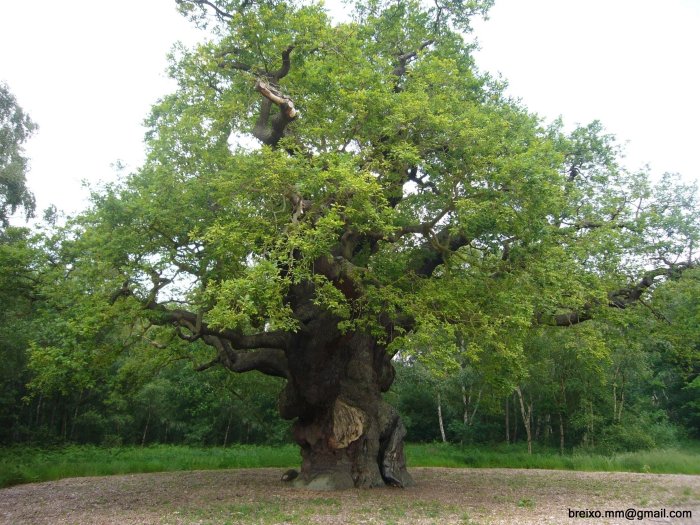

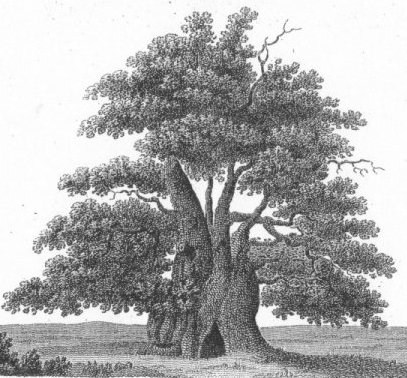
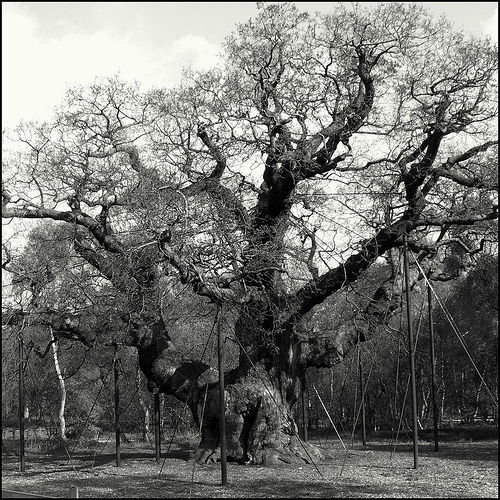
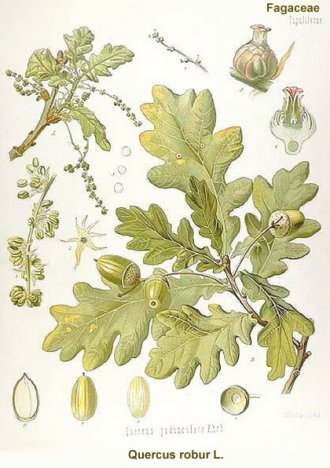

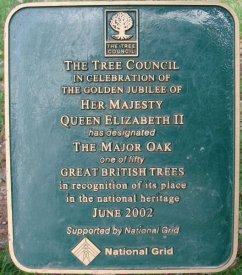

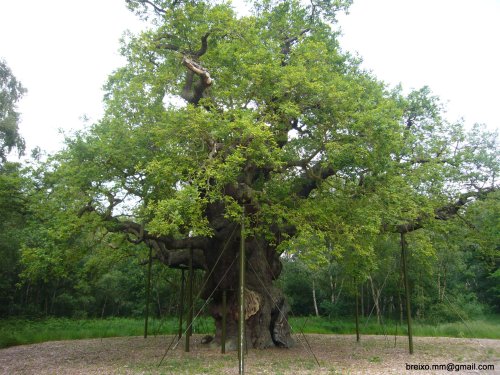
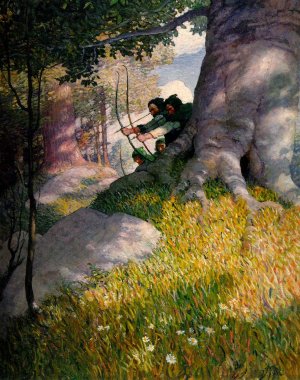 Legend has it that once upon a time
Legend has it that once upon a time
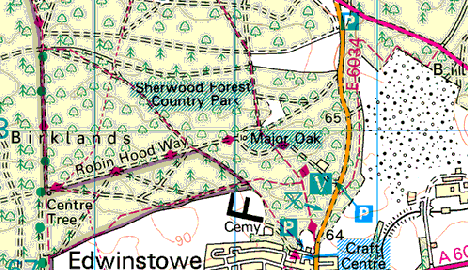 The Major Oak is free and easy to reach, 15 minutes along a footpath,
just North of Edwinstowe, Nottinghamshire, England.
Sherwood Forest has many big old oaks lurking near the footpath.
The free Visitor's Centre tells of the Major Oak and
The Major Oak is free and easy to reach, 15 minutes along a footpath,
just North of Edwinstowe, Nottinghamshire, England.
Sherwood Forest has many big old oaks lurking near the footpath.
The free Visitor's Centre tells of the Major Oak and  Why not stay at the modern
Youth Hostel in Edwinstowe?
There's a free car-park
and meals are prepared.
Its an easy signposted walk
from the Hostel through the Forest
to the Major Oak.
See details and book via the
Why not stay at the modern
Youth Hostel in Edwinstowe?
There's a free car-park
and meals are prepared.
Its an easy signposted walk
from the Hostel through the Forest
to the Major Oak.
See details and book via the


